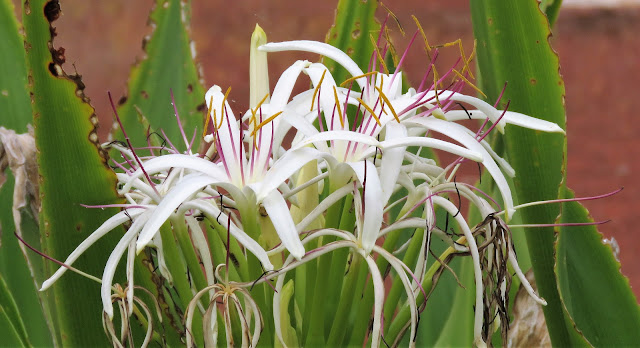Local lily thrives roadside or seaside
Krinon was a word used in Ancient Greece for a white lily. Today, with a little 'Latinisation', we apply this name to the members of the genus Crinum. As I've mentioned before, we have one rather well-known species of Krinon native to Australia, Crinum pedunculatum. It's also known as Swamp Lily, in recognition of its favoured habitat - poorly drained, clay soils.
As with the Gymea Lily (Doryanthes excelsa; and also Doryanthes palmeri), the strappy leaves and flowers seem quite out of place in the Australian bushland. Nothing subtle about leaves to three metres long and paper-white flowers about 10 cm across.
There are one hundred species of Crinum, mostly in Africa but with 13 native to Australia. The Swamp Lily, Crinum pedunculatum, can be found in near coastal wet areas of northern Australia - as far south as Jervis Bay - and in New Guinea and other Pacific Islands. Typically it grows along stream banks and in swamps.
Sometimes Crinum peduculatum is considered a variety (var. pedunculatum) of the more widespread Crinum asiaticum. While the differences are rather minor (mostly in the size of the plant and flowers), most Australian floras accept it as a good species.
The flowers of all Crinum are wonderfully simple to dissect, mentally. There are six petals (technically 'tepals' because they are (n)either petal nor sepal), fused into a tube at the base, with six elongate male parts (stamens) protruding skyward. The ovary is embedded below stamens and tepals, topped by a thin receptive style.
In the Swamp Lily, the flowers are white, and the tepals narrow, curving outwards, and up to about 8 centimetres long. The pollen-bearing anthers, at the end of the stamens, are straight (rather than strongly curved as they are in another similar looking species, Crinum flaccidum), and the style looks like a stamen with the top broken off...
Like Gymea Lily, Swamp Lily is a good roadside planting - from Queensland to Victoria (and beyond!) - needing little care or attention once established. In sun or shade: in the Australian Garden we have a clump in full sun at the top of the Rockpool Waterway, and another in a shaded nook of the Gondwana Garden. My pictures are from the waterway.
Swamp Lily has also been used to reduce turbidity in estuarine areas. In the Brisbane River, for example, mass plantings now intercept waves so that 'calm-wind' conditions are maintained at all times. That means more transparent, appealing, water.
So the Swamp Lily is a very practical Australian plant, despite looking more exotic than it is - which will be a pro or a con, depending on your floristic patriotism.





Comments